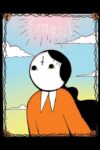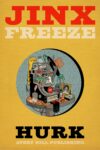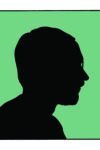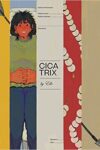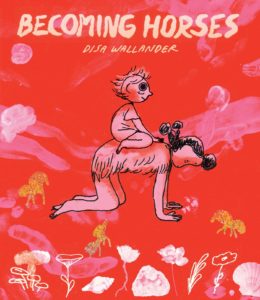
[Drawn & Quarterly; 2020]
“You soothe yourself by eating the world whole,” a painter says in the Swedish cartoonist Disa Wallander’s hypnotic, psychedelic Becoming Horses. Like many characters in the book, the painter is caught creating something and asked to explain her intent. Her canvas is a miniature watercolor, a black background with splashes of pink, grey, orange, blue, and green. “It’s the essence of a human being,” she explains.
Becoming Horses is a kunstlerinroman which playfully pokes fun at the piety and self-seriousness of the art world without descending into bitterness. The book has three unnamed protagonists, whom I’ll call Chignon, Pigpen, and Bird Hair. They wander across pages of watercolor, collage, and photographs of 3D materials, interacting with the features of their background in the dreamlike way one would interact with thoughts in one’s mind: picking things up, putting them down, ruminating on them, shoving them away. Chignon is something of a know-it-all, determining from the start what’s valuable and interesting (a piece of foil, a pompom) and what’s not (a watercolor tulip — “too modern”). Pigpen is the image of childlike wonder, asking innocent questions of the various creators she meets and happily imitating them. Bird Hair, the least present of the three, is constantly misunderstanding things and getting frustrated and angry — the prosaic non-artist who imposes her limited understanding on the creativity around her. But when the three of them are swallowed by a giant, naked woman halfway through the book, Chignon and Bird Hair lose their negativity and become as openly curious as Pigpen. Tourists in a mind, they meet a series of artists — or thoughts — who make them sit on gems and turn into clay sculptures and swallow their feelings until their bodies radiate them.
If the world of Becoming Horses seems simple and even a little naïve, it’s because it has to be. It’s a bare bones affirmation of a thinking subject’s existence. Wallander’s author bio reads that “in her early twenties, she read some philosophy books that suggested nothing was real and ever since then she has made comics with the compulsion to affirm the existence of the world inside her head.” I was reminded of Descartes’s doubt about the existence of an external world, which he at least partially overcomes with the fragment of knowledge that he thinks and therefore must exist: the famous cogito ergo sum. I also thought of Crockett Johnson’s 1955 Harold and the Purple Crayon, a favorite book of mine when I was a child. With nothing but a purple crayon, Harold wanders through a blank canvas — a mind, maybe — and draws an entire world: boats, hot air balloons, a picnic of nine pies and a moose to eat them. Like Descartes and Harold, Wallander’s characters are creating an internal world that confirms the existence of the thoughts (and art, the relatable and beautiful and confounding product of thoughts) they generate simply by being human.
At several points in the book, humans become horses: sometimes as a form of play and sometimes by a kind of terrifying, skin-melting process which cannot be helped. Becoming a horse seems to mean becoming the opposite of Chignon and Bird Hair’s rigid determinism, of the painter who at one point tells Chignon in the parlance of the Serious Art Critic not to be “banal” when Chignon asks her why she doesn’t paint sunsets. Writes Wallander: “Watching a horse run away is one of the world’s greatest pleasures.” The horse herself claims to be “full of freedom” as she runs. It’s this guileless indulgence in creative freedom that makes Becoming Horses such a joy to read. This is Harold and the Purple Crayon for adults, a road map for anyone who makes or wants to make art. It’s a book about creating a beautiful world inside your head and allowing yourself to feel celebratory, even euphoric, while doing so.
R. A. Frumkin is the author of The Comedown, which was published by Henry Holt in 2018. In the fall, she will begin as an assistant professor of English and creative writing at Southern Illinois University.
This post may contain affiliate links.




